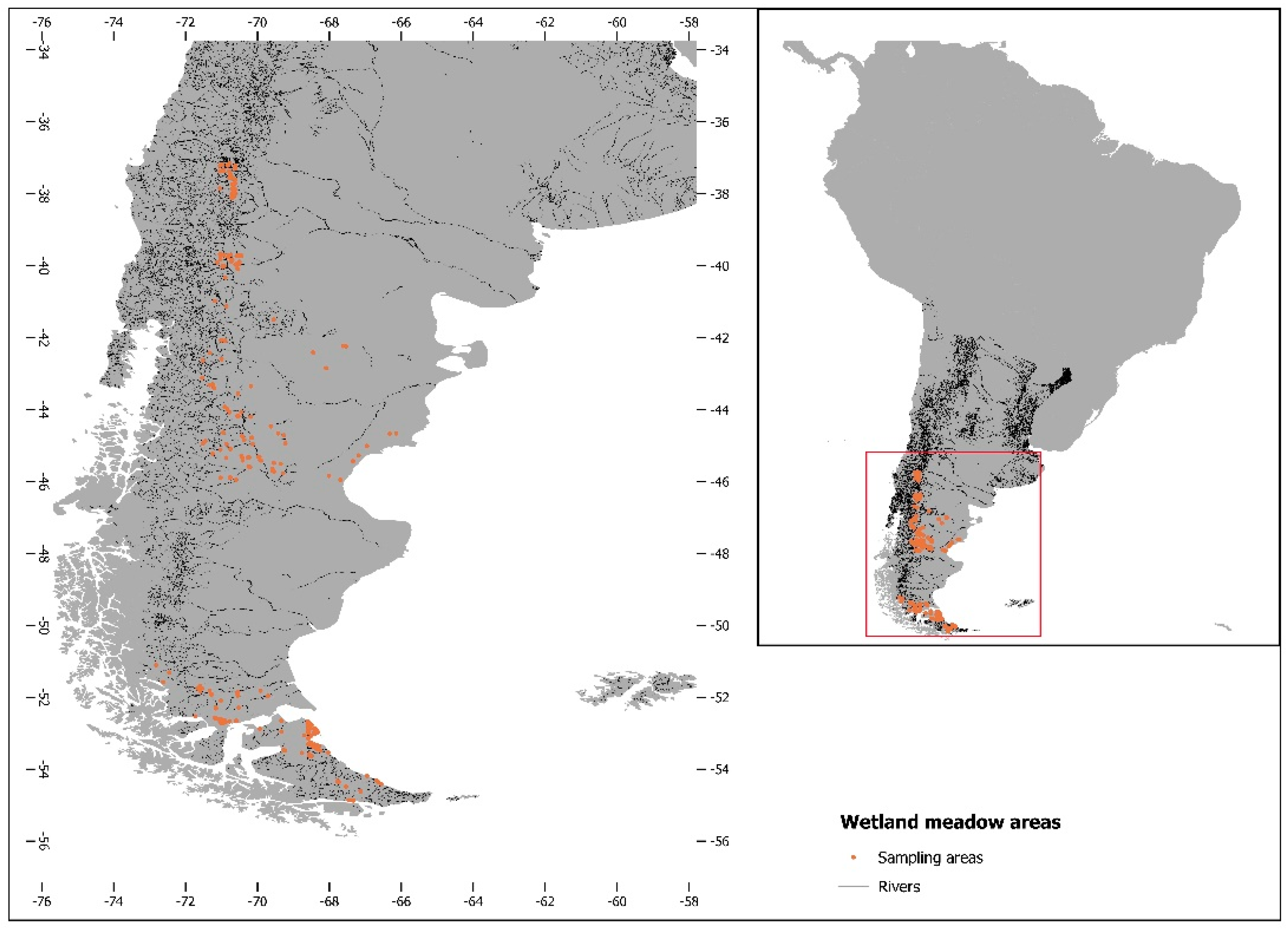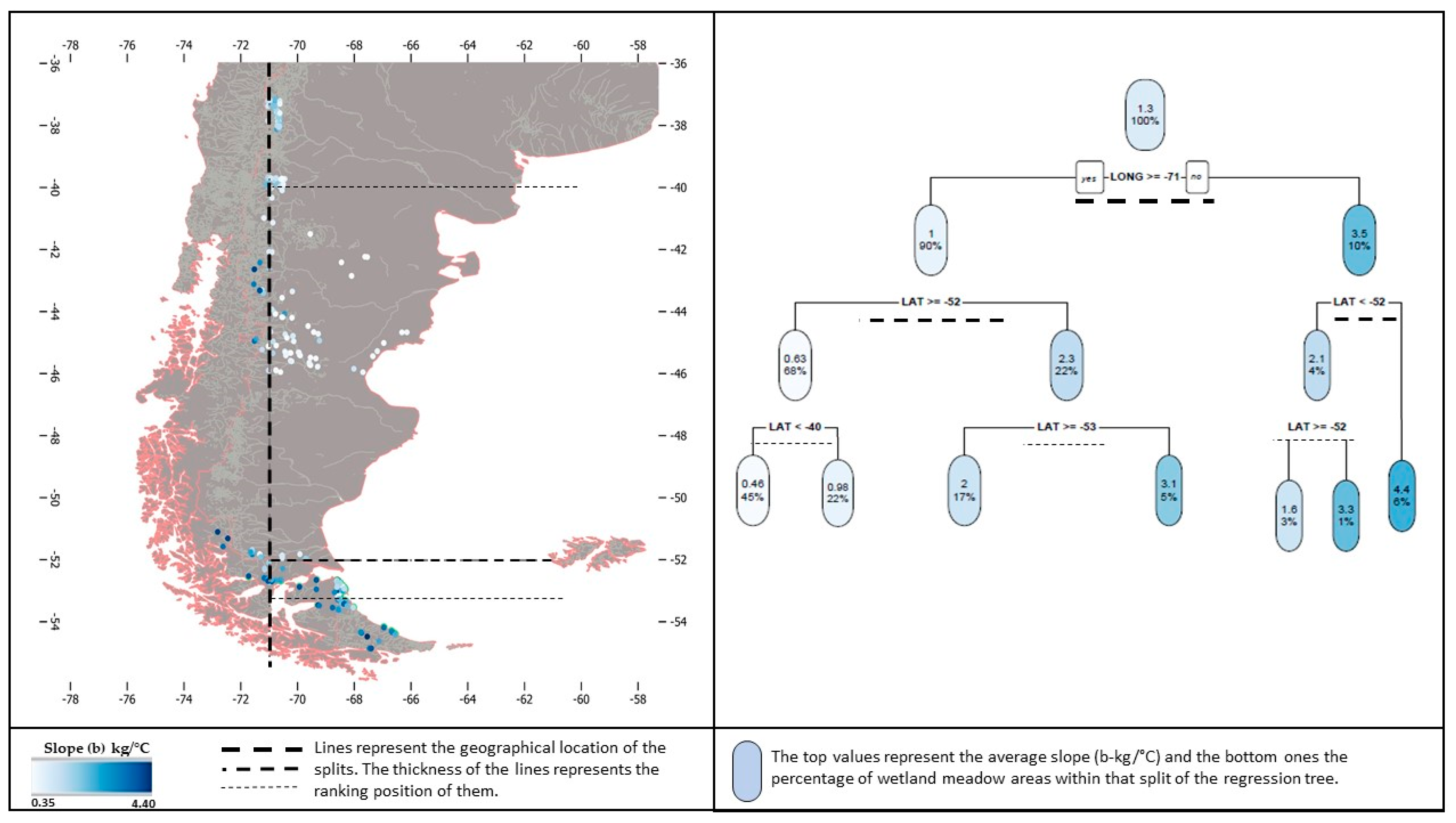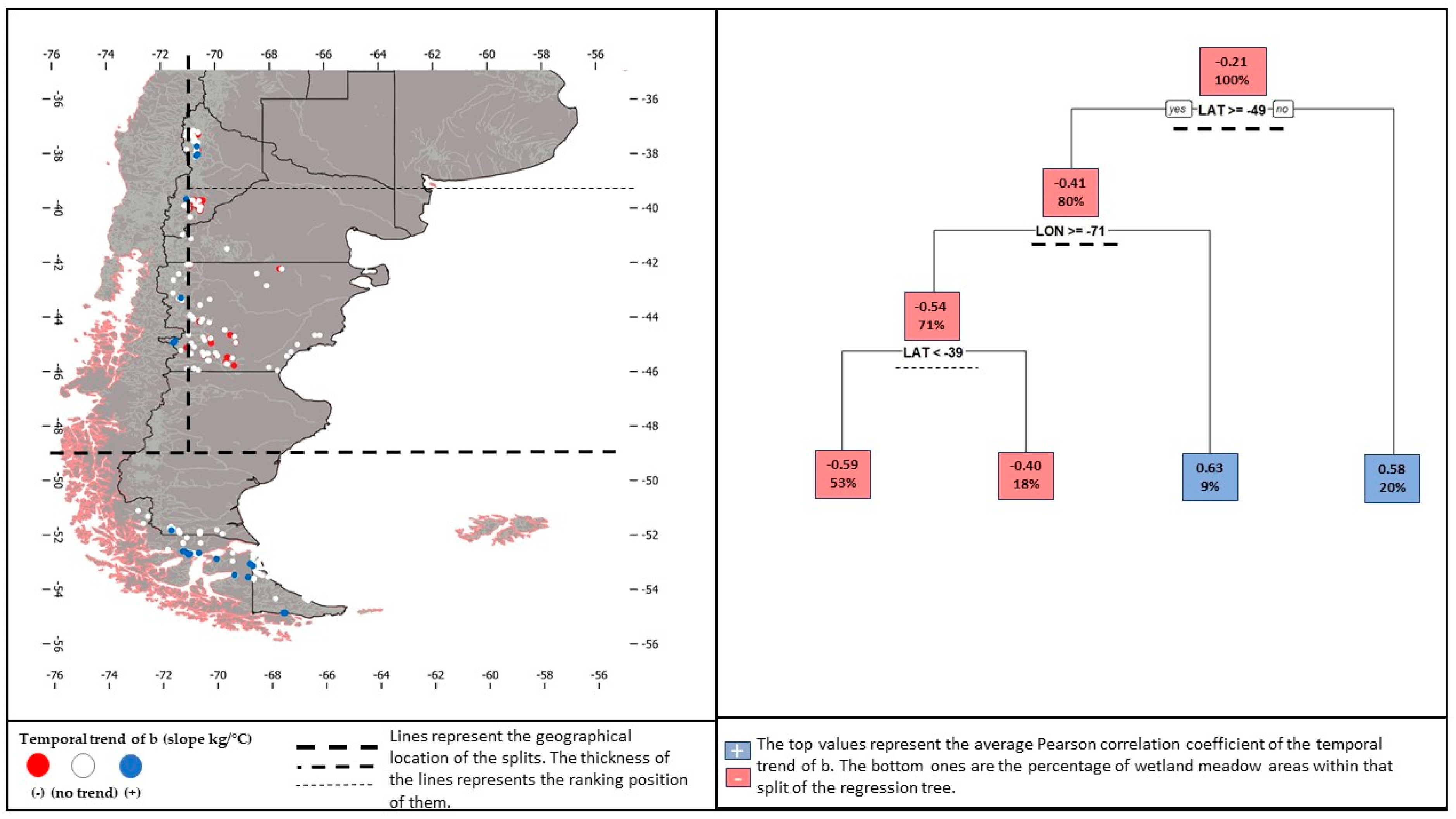Trends in ANPP Response to Temperature in Wetland Meadows across a Subcontinental Gradient in Patagonia
Abstract
1. Introduction
2. Materials and Methods
2.1. Site Description
2.2. ANPP Monthly Association with Temperature
2.3. Spatial and Inter-Annual Variation in the Slope
3. Results
3.1. ANPP Monthly Association with Temperature
3.2. Temporal Trends of ANPP Response to Temperature
4. Discussion
5. Conclusions
Supplementary Materials
Author Contributions
Funding
Acknowledgments
Conflicts of Interest
References
- Morgan, J.A.; Parton, W.; Derner, J.D.; Gilmanov, T.G.; Smith, D.P. Importance of early season conditions and grazing on carbon dioxide fluxes in Colorado shortgrass steppe. Rangel. Ecol. Manag. 2016, 69, 342–350. [Google Scholar] [CrossRef]
- Polley, H.W.; Briske, D.D.; Morgan, J.A.; Wolter, K.; Bailey, D.W.; Brown, J.R. Climate change and North American rangelands: Trends, projections, and implications. Rangel. Ecol. Manag. 2013, 66, 493–511. [Google Scholar] [CrossRef]
- Huxman, T.E.; Smith, M.D.; Fay, P.A.; Knapp, A.K.; Shaw, M.R.; Loik, M.E.; Smith, S.D.; Tissue, D.T.; Zak, J.C.; Weltzin, J.F.; et al. Convergence across biomes to a common rain-use ef ciency. Nature 2004, 429, 651–654. [Google Scholar] [CrossRef]
- Sala, O.E.; Gherardi, L.A.; Reichmann, L.; Jobbágy, E.; Peters, D. Legacies of precipitation fluctuations on primary production: Theory and data synthesis. Philos. Trans. R. Soc. Lond. B. Biol. Sci. 2012, 367, 3135–3144. [Google Scholar] [CrossRef]
- Irisarri, J.G.N.; Derner, J.D.; Porensky, L.M.; Augustine, D.J.; Reeves, J.L.; Mueller, K.E. Grazing intensity differentially regulates ANPP response to precipitation in North American semiarid grasslands. Ecol. Appl. 2016, 26, 1370–1380. [Google Scholar] [CrossRef]
- Lauenroth, W.K.; Sala, O.E. Long-term forage production of North American shortgrass steppe. Ecol. Appl. 1992, 2, 397–403. [Google Scholar] [CrossRef]
- Durante, M.; Piñeiro, G.; Irisarri, J.G.N.; Oesterheld, M. Primary Production of Lowland Natural Grasslands and Upland Sown Pastures Across a Narrow Climatic Gradient. Ecosystems 2017, 20, 543–552. [Google Scholar] [CrossRef]
- Knapp, A.K.; Ciais, P.; Smith, M.D. Tansley insight Reconciling inconsistencies in precipitation—Productivity relationships: Implications for climate change. New Phytol. 2017, 241, 41–47. [Google Scholar] [CrossRef]
- Verón, S.R.; Paruelo, J.M. Desertification alters the response of vegetation to changes in precipitation. J. Appl. Ecol. 2010, 47, 1233–1241. [Google Scholar] [CrossRef]
- Augustine, D.J.; Blumenthal, D.M.; Springer, T.L.; Lecain, D.R.; Gunter, S.A.; Derner, J.D. Elevated CO2 induces substantial and persistent declines in forage quality irrespective of warming in mixedgrass prairie. Ecol. Appl. 2018, 28, 721–735. [Google Scholar] [CrossRef]
- Gaitán, J.J.; Bran, D.; Oliva, G.; Maestre, F.T.; Aguiar, M.R.; Jobbágy, E.; Buono, G.; Ferrante, D.; Nakamatsu, V.; Ciari, G.; et al. Plant species richness and shrub cover attenuate drought effects on ecosystem functioning across Patagonian rangelands. Biol. Lett. 2014, 10, 20140673. [Google Scholar] [CrossRef]
- Maestre, F.T.; Eldridge, D.J.; Soliveres, S.; Kéfi, S.; Delgado-Baquerizo, M.; Bowker, M.A.; García-Palacios, P.; Gaitán, J.; Gallardo, A.; Lázaro, R.; et al. Structure and Functioning of Dryland Ecosystems in a Changing World. Annu. Rev. Ecol. Evol. Syst. 2016, 47, 215–237. [Google Scholar] [CrossRef]
- Chapin, F.S.I.; Matson, P.A.; Vitousek, P.M. Principles of Terrestrial Ecosystem Ecology, 2nd ed.; Chapin, F.S.I., Matson, P.A., Vitousek, P.M., Eds.; Springer: New York, NY, USA, 2011; ISBN 9781441995032. [Google Scholar]
- Monteith, J.L. Climate and the efficiency of crop production in Britain. Philos. Trans. R. Soc. London B Biol. Sci. 1977, 281, 277–294. [Google Scholar]
- Irisarri, J.G.N.; Oesterheld, M.; Paruelo, J.M.; Texeira, M.A. Patterns and controls of above-ground net primary production in meadows of Patagonia. A remote sensing approach. J. Veg. Sci. 2011, 23, 114–126. [Google Scholar] [CrossRef]
- Bandieri, L.M.; Fernández, R.J.; Bisigato, A.J. Risks of Neglecting Phenology When Assessing Climatic Controls of Primary Production. Ecosystems 2020, 23, 164–174. [Google Scholar] [CrossRef]
- Paruelo, J.M.; Jobbagy, E.G.; Sala, O.E. Current distribution of ecosystem functional types in temperate South America. Ecosystems 2001, 4, 683–698. [Google Scholar] [CrossRef]
- Billings, W.D.; Mooney, H.A. The ecology of artic and alpine plants. Biol. Rev. 1968, 43, 481–529. [Google Scholar] [CrossRef]
- Jobbágy, E.G.; Sala, O.E.; Paruelo, J.M. Patterns and controls of primary production in the Patagonian steppe: A remote sensing approach. Ecology 2002, 83, 307–319. [Google Scholar] [CrossRef][Green Version]
- Reeves, J.L.; Derner, J.D.; Sanderson, M.A.; Hendrickson, J.R.; Kronberg, S.L.; Petersen, M.K.; Vermeire, L.T. Seasonal weather influences on yearling beef steer production in C3-dominated Northern Great Plains rangeland. Agric. Ecosyst. Environ. 2014, 183, 110–117. [Google Scholar] [CrossRef]
- Texeira, M.; Paruelo, J.M.; Jobbagy, E. How do forage availability and climate control sheep reproductive performance?: An analysis based on artificial neural networks and remotely sensed data. Ecol. Modell. 2008, 217, 197–206. [Google Scholar] [CrossRef]
- Pettorelli, N.; Gaillard, J.M.; Mysterud, A.; Duncan, P.; Stenseth, N.C.; Delorme, D.; Van Laere, G.; Toi, C.; Van Laere, G.; Toïgo, C.; et al. Using a proxy of plant productivity (NDVI) to find key periods for animal performance: The case of roe deer. Oikos 2006, 112, 565–572. [Google Scholar] [CrossRef]
- Pettorelli, N.; Weladji, R.B.; Holand, O.; Mysterud, A.; Breie, H.; Stenseth, N.C. The relative role of winter and spring conditions: Linking climate and landscape-scale plant phenology to alpine reindeer body mass. Biol. Lett. 2005, 1, 24–26. [Google Scholar] [CrossRef]
- Alcaraz, D.; Paruelo, J.; Cabello, J. Identification of current ecosystem functional types in the Iberian Peninsula. Glob. Ecol. Biogeogr. 2006, 15, 200–212. [Google Scholar] [CrossRef]
- Paruelo, J.M.; Jobbagy, E.G.; Sala, O.E.; Lauenroth, W.K.; Burke, I.C. Functional and structural convergence of temperate grassland and shrubland ecosystems. Ecol. Appl. 1998, 8, 194–206. [Google Scholar] [CrossRef]
- Wang, H.; Liu, H.; Cao, G.; Ma, Z.; Li, Y.; Zhang, F.; Zhao, X.; Zhao, X.; Jiang, L.; Sanders, N.J.; et al. Alpine grassland plants grow earlier and faster but biomass remains unchanged over 35 years of climate change. Ecol. Lett. 2020, 23, 701–710. [Google Scholar] [CrossRef] [PubMed]
- Crego, R.D.; Didier, K.A.; Nielsen, C.K. Modeling meadow distribution for conservation action in arid and semi-arid Patagonia, Argentina. J. Arid Environ. 2014, 102, 68–75. [Google Scholar] [CrossRef]
- Golluscio, R.; Paruelo, J.; Deregibus, A. Sustainability and range management in the Patagonian steppes. Ecol. Austral 1998, 8, 265–284. [Google Scholar]
- Gaitán, J.J.; López, C.R.; Bran, D.E. Vegetation composition and its relationship with the environment in mallines of north Patagonia, Argentina. Wetl. Ecol. Manag. 2011, 19, 121–130. [Google Scholar] [CrossRef]
- Collantes, M.B.; Anchorena, J.; Stoffella, S.; Escartín, C.; Rauber, R. Wetlands of the magellanic steppe (Tierra del Fuego, Argentina). Folia Geobot. 2009, 44, 227–245. [Google Scholar] [CrossRef]
- Chimner, R.A.; Bonvissuto, G.L.; Victoria Cremona, M.; Gaitan, J.J.; López, C.R.; Cremona, M.V.; Gaitan, J.J.; Lopez, C.R. Ecohydrological conditions of wetlands along a precipitation gradient in Patagonia, Argentina. Ecol. Austral 2011, 21, 329–337. [Google Scholar]
- Enriquez, A.S.; Chimner, R.A.; Cremona, M.V.; Diehl, P.; Bonvissuto, G.L. Grazing intensity levels influence C reservoirs of wet and mesic meadows along a precipitation gradient in Northern Patagonia. Wetl. Ecol. Manag. 2015, 23, 439–451. [Google Scholar] [CrossRef]
- Texeira, M.; Baldi, G.; Paruelo, J. An exploration of direct and indirect drivers of herbivore reproductive performance in arid and semi arid rangelands by means of structural equation models. J. Arid Environ. 2012, 81, 26–34. [Google Scholar] [CrossRef]
- Cipriotti, P.A.; Collantes, M.B.; Rauber, R.B.; Braun, K.; Escartín, C. Inter-Annual and Seasonal Variation of ANPP and Leaf Nutrient Concentration in Cold-Temperate Wetlands of Tierra del Fuego. Wetlands 2018, 38, 37–49. [Google Scholar] [CrossRef]
- Buono, G.; Oesterheld, M.; Nakamatsu, V.; Paruelo, J.M. Spatial and temporal variation of primary production of Patagonian wet meadows. J. Arid Environ. 2010, 74, 1257–1261. [Google Scholar] [CrossRef]
- Paruelo, J.M.; Golluscio, R.A.; Guerschman, J.P. Regional scale relationships between ecosystem structure and functioning: The case of the Patagonian steppes. Glob. Ecol. Biogeogr. 2004, 13, 385–395. [Google Scholar] [CrossRef]
- García Martínez, G.C.; Ciari, G.; Gaitan, J.; Caruso, C.; Nagahama, N.; Opazo, W.; Nakamatsu, V.; Lloyd, C.; Cotut, C.; Irisarri, G.; et al. Analysis of the evolution of climate and natural grasslands in northwest Chubut province, Argentina, between 2000 and 2014: Identification of variables associated with livestock decrease in the region. AgriScientia 2017, 34, 59–69. [Google Scholar] [CrossRef]
- Paruelo, J.M.; Beltrán, A.; Jobbágy, E.; Sala, O.E.; Golluscio, R.A. The climate of Patagonia: General patterns and controls on biotic processes. Ecol. Austral 1998, 8, 85–101. [Google Scholar]
- Oliva, G.; Gaitan, J.; Ferrante, D. Humans Cause Deserts: Evidence of Irreversible Changes in Argentinian Patagonia Rangelands. In The End of Desertification? Springer: Berlin/Heidelberg, Germany, 2016; pp. 363–386. ISBN 978-3-642-16013-4. [Google Scholar]
- Jobbágy, E.G.; Paruelo, J.M.; León, R.J.C. Estimación del régimen de precipitación a partir de la distancia a la cordillera en el noroeste de la Patagonia. Ecol. Austral 1995, 5, 47–53. [Google Scholar]
- Soriano, A. Los distritos florísticos de la provincia patagónica. Rev. Investig. Agrícolas 1956, 10, 323–347. [Google Scholar]
- León, R.J.C.; Bran, D.E.; Collantes, M.B.; Paruelo, J.M.; Soriano, A. grandes unidades de vegetación de la Patagonia extra andina. Ecol. Austral 1998, 8, 125–144. [Google Scholar]
- Boelcke, O. Comunidades herbaceas del norte de Patagonia y sus relaciones con la ganaderia. Rev. Investig. Agric. 1957, 11, 5–98. [Google Scholar]
- Mazzoni, E.; Rabassa, J. Types and internal hydro-geomorphologic variability of mallines (wet-meadows) of Patagonia: Emphasis on volcanic plateaus. J. S. Am. Earth Sci. 2013, 46, 170–182. [Google Scholar] [CrossRef]
- Easdale, M.; Gaitán, J. Relación entre la superficie y clase de mallines y la composición de la estructura ganadera en establecimientos del noroeste de la Patagonia. Rev. Argentina Prod. Anim. 2013, 30, 69–80. [Google Scholar]
- Abatzoglou, J.T.; Dobrowski, S.Z.; Parks, S.A.; Hegewisch, K.C. TerraClimate, a high-resolution global dataset of monthly climate and climatic water balance from 1958–2015. Sci. Data 2018, 5, 170191. [Google Scholar] [CrossRef] [PubMed]
- Muñoz Sabater, J. ERA5-Land Monthly Averaged Data from 1981 to Present. Available online: https://cds.climate.copernicus.eu/cdsapp#!/dataset/reanalysis-era5-land-monthly-means?tab=overview (accessed on 1 February 2022).
- Gorelick, N.; Hancher, M.; Dixon, M.; Ilyushchenko, S.; Thau, D.; Moore, R. Google Earth Engine: Planetary-scale geospatial analysis for everyone. Remote Sens. Environ. 2017, 202, 18–27. [Google Scholar] [CrossRef]
- Pinheiro, J.; Bates, D.; DebRoy, S.; Sarkar, D. R. Core Team. Linear and Non-linear Mixed Effects Models, R Package Version 3.1-108; R Package Vignette: Madison, WI, USA, 2013; pp. 1–108. Available online: https://rdrr.io/cran/nlme/ (accessed on 1 February 2022).
- Therneau, T.; Atkinson, B. Rpart: Recursive Partitioning and Regression Trees, R package version 4.1-15 2019. Available online: https://rdrr.io/cran/rpart/ (accessed on 1 February 2022).
- Breiman, L.; Friedman, J.H.; Olshen, R.A.; Stone, C.J. Classification and Regression Trees; Taylor & Francis: Boca Raton, FL, USA, 1984; ISBN 9781351460491. [Google Scholar]
- Posse, G.; Anchorena, J.; Collantes, M.B. Seasonal diets of sheep in the steppe region of Tierra del Fuego, Argentina. J. Range Manag. 1996, 49, 24–30. [Google Scholar] [CrossRef]
- Paruelo, J.M.; Aguiar, M.R. Impacto humano sobre los ecosistemas: El caso de la desertificación. Cienc. Hoy 2003, 13, 48–59. [Google Scholar]
- Aragón, R.; Oesterheld, M.; Irisarri, G.; Texeira, M. Stability of ecosystem functioning and diversity of grasslands at the landscape scale. Landsc. Ecol. 2011, 26, 1011–1022. [Google Scholar] [CrossRef]
- Masson-Delmotte, V.; Zhai, P.; Pörtner, H.-O.; Roberts, D.; Skea, J.; Shukla, P.R.; Pirani, A.; Moufouma-Okia, W.; Péan, C.; Pidcock, R.; et al. Global Warming of 1.5 °C—An IPCC Special Report on the Impacts of Global Warming of 1.5 °C above Pre-Industrial Levels and Related Global Greenhouse Gas Emission Pathways, in the Context of Strengthening the Global Response to the Threat of Climate Change, Sustainable Development, and Efforts to Eradicate Poverty. Available online: https://www.ipcc.ch/sr15/ (accessed on 10 February 2022).
- Jia, G.; Shevliakova, E.; Artaxo, P.; De Noblet-Ducoudré, N.; Houghton, R.; Anderegg, W.; Bernier, P.; Carlo Espinoza, J.; Semenov, S.; Xu, X.; et al. Climate Change and Land—An IPCC Special Report on Climate Change, Desertification, Land Degradation, Sustainable Land Management, Food Security, and Greenhouse Gas Gluxes in Terrestrial Ecosystems. Available online: https://www.ipcc.ch/srccl/ (accessed on 10 February 2022).
- Maestre, F.T.; Quero, J.L.; Gotelli, N.J.; Escudero, A.; Ochoa, V.; Delgado-baquerizo, M.; García-gómez, M.; Bowker, M.A.; Soliveres, S.; Escolar, C.; et al. Plant Species Richness and Ecosystems Multifunctionality in Global Drylands. Science 2012, 335, 2014–2017. [Google Scholar] [CrossRef]
- Oliva, G.; Paredes, P.; Ferrante, D.; Cepeda, C.; Rabinovich, J. Remotely sensed primary productivity shows that domestic and native herbivores combined are overgrazing Patagonia. J. Appl. Ecol. 2019, 56, 1575–1584. [Google Scholar] [CrossRef]
- Cipriotti, P.A.; Aguiar, M.R.; Wiegand, T.; Paruelo, J.M. Combined effects of grazing management and climate on semi-arid steppes: Hysteresis dynamics prevent recovery of degraded rangelands. J. Appl. Ecol. 2019, 56, 2155–2165. [Google Scholar] [CrossRef]
- Soriano, A.; Sala, O. Ecological strategies in a Patagonian steppe. Vegetatio 1983, 56, 9–15. [Google Scholar] [CrossRef]
- Oñatibia, G.R.; Aguiar, M.R. Grasses and grazers in arid rangelands: Impact of sheep management on forage and non-forage grass populations. J. Environ. Manag. 2019, 235, 42–50. [Google Scholar] [CrossRef] [PubMed]
- Wessels, K.J.; Prince, S.D.; Frost, P.E.; Van Zyl, D.; Zyl, V.D. Assessing the effects of human-induced land degradation in the former homelands of northern South Africa with a 1 km AVHRR NDVI time-series. Remote Sens. Environ. 2004, 91, 47–67. [Google Scholar] [CrossRef]
- Kaptué, A.T.; Prihodko, L.; Hanan, N.P.; Turner, B.L. On regreening and degradation in Sahelian watersheds. Proc. Natl. Acad. Sci. USA 2015, 112, 12133–12138. [Google Scholar] [CrossRef]
- Verón, S.R.; Blanco, L.J.; Texeira, M.A.; Irisarri, J.G.N.; Paruelo, J.M. Desertification and ecosystem services supply: The case of the Arid Chaco of South America. J. Arid Environ. 2018, 159, 66–74. [Google Scholar] [CrossRef]
- Texeira, M.; Veron, S.; Irisarri, G.; Oyarzabal, M.; Staiano, L.; Baeza, S.; Paruelo, J. Functional syndromes as indicators of ecosystem change in temperate grasslands. Ecol. Indic. 2019, 96, 600–610. [Google Scholar] [CrossRef]
- Irisarri, J.G.N.; Texeira, M.; Oesterheld, M.; Verón, S.R.; Nave, F.D.; Paruelo, J.M. Discriminating the biophysical signal from human-induced effects on long-term primary production dynamics. The case of Patagonia. Glob. Chang. Biol. 2021, 27, 4381–4391. [Google Scholar] [CrossRef]




Publisher’s Note: MDPI stays neutral with regard to jurisdictional claims in published maps and institutional affiliations. |
© 2022 by the authors. Licensee MDPI, Basel, Switzerland. This article is an open access article distributed under the terms and conditions of the Creative Commons Attribution (CC BY) license (https://creativecommons.org/licenses/by/4.0/).
Share and Cite
Irisarri, J.G.N.; Cipriotti, P.A.; Texeira, M.; Curcio, M.H. Trends in ANPP Response to Temperature in Wetland Meadows across a Subcontinental Gradient in Patagonia. Meteorology 2022, 1, 220-230. https://doi.org/10.3390/meteorology1020015
Irisarri JGN, Cipriotti PA, Texeira M, Curcio MH. Trends in ANPP Response to Temperature in Wetland Meadows across a Subcontinental Gradient in Patagonia. Meteorology. 2022; 1(2):220-230. https://doi.org/10.3390/meteorology1020015
Chicago/Turabian StyleIrisarri, Jorge Gonzalo N., Pablo A. Cipriotti, Marcos Texeira, and Matias H. Curcio. 2022. "Trends in ANPP Response to Temperature in Wetland Meadows across a Subcontinental Gradient in Patagonia" Meteorology 1, no. 2: 220-230. https://doi.org/10.3390/meteorology1020015
APA StyleIrisarri, J. G. N., Cipriotti, P. A., Texeira, M., & Curcio, M. H. (2022). Trends in ANPP Response to Temperature in Wetland Meadows across a Subcontinental Gradient in Patagonia. Meteorology, 1(2), 220-230. https://doi.org/10.3390/meteorology1020015





